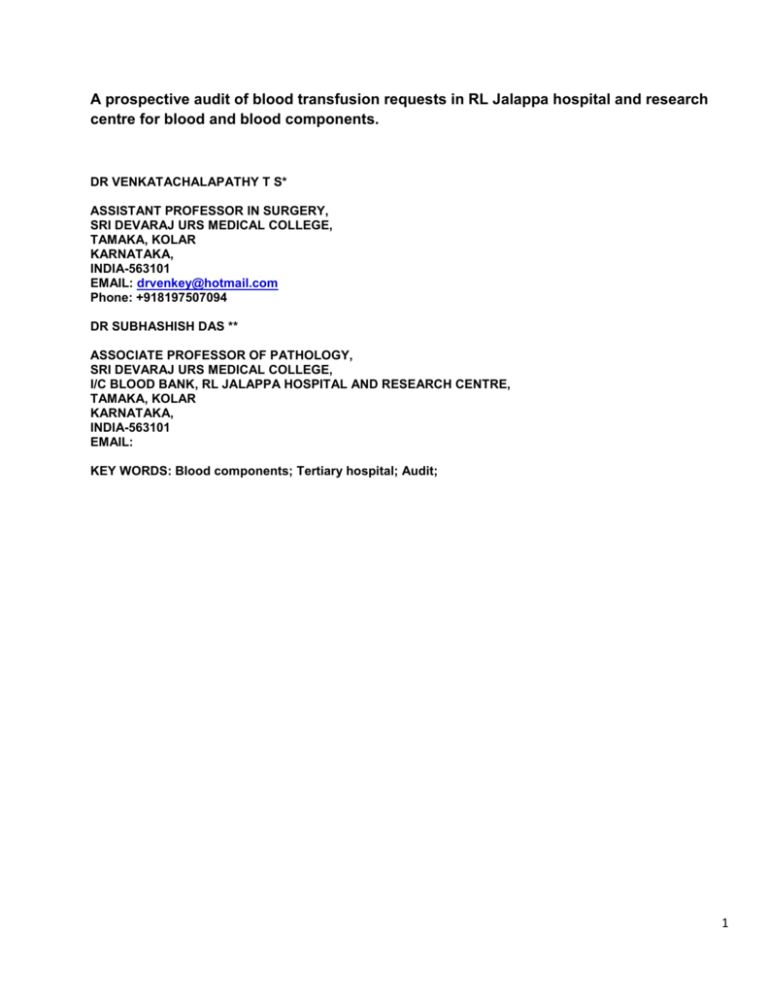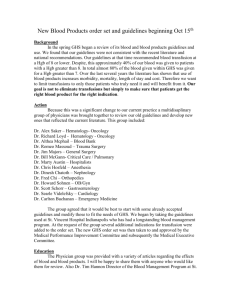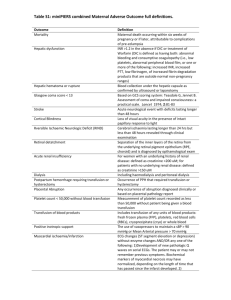uploaded_doc - Indian Journal of Transfusion Medicine
advertisement

A prospective audit of blood transfusion requests in RL Jalappa hospital and research centre for blood and blood components. DR VENKATACHALAPATHY T S* ASSISTANT PROFESSOR IN SURGERY, SRI DEVARAJ URS MEDICAL COLLEGE, TAMAKA, KOLAR KARNATAKA, INDIA-563101 EMAIL: drvenkey@hotmail.com Phone: +918197507094 DR SUBHASHISH DAS ** ASSOCIATE PROFESSOR OF PATHOLOGY, SRI DEVARAJ URS MEDICAL COLLEGE, I/C BLOOD BANK, RL JALAPPA HOSPITAL AND RESEARCH CENTRE, TAMAKA, KOLAR KARNATAKA, INDIA-563101 EMAIL: KEY WORDS: Blood components; Tertiary hospital; Audit; 1 A prospective audit of blood transfusion requests in RL Jalappa hospital and research centre for blood and blood components. Dr Venkatachalapathy T S *, Dr Subhashish Das**, Abstract: Predetermined transfusion guidelines, pre transfusion approval, and transfusion audits are useful tools in the education of those ordering blood components, potentially resulting in the reduction of inappropriate use of blood components. In most cases, blood components released based on the demand of the ordering physician, despite the advice of the blood bank physician, were deemed as inappropriate transfusions. The present study was conducted upon 1694 episodes of transfusion units for different blood components over a period of 3 months from November 2011 to January 2012. Of the total 1694 transfusion episodes in 920 requests for 796 patients. 124 patients had multiple requests. 208 males and 588 were females. . Single unit requisitions were 456, and two unit requisitions were 354, and 3 or more unit requisition in 110 requests. 222 requests contained >10 gms% as indication, 330 requests had 7.1- 9.9 gms%, and 250 requests with <7 gms%. Elective transfusion requests found in 100 requests and 369 had emergency request, and 451 didn’t contain any information. 136 patients received single unit transfusion. 660 patients had 2 or more than 2 unit transfusion. During this 3 month period 20.3 units /day was bled at blood bank and in camps. 26.4 units/day issued to both IP and OP requests. 18.4 units/day was issued to IP requests. 450 requests from OBG dept, 735 requests had indication for blood transfusion written in the requisition. This study therefore suggests that prospective audits of blood component orders can help reduce inappropriate transfusions and can be a valuable educational tool for the ordering physicians as well as for residents in training. Introduction: The blood component implies separation of whole blood into various potential components like packed red cells, Platelet rich plasma, fresh frozen plasma, cryoprecipitate and leucocytes. Blood and its components are an important Part of patient management treatment protocols and like drugs have property to cause adverse reactions in the Recipients. To maximize the effectiveness, safety and utility clinicians and intravenous therapists should be Knowledgeable about the potential risk of blood component therapy. Therefore the clinician should keep in mind the appropriate indication for ordering blood components there by Avoid misuse and unnecessary exposure of the recipient to various infectious and non infectious complications. Hence, regular audit of blood and its component usage is essential to access the blood utilization pattern and set Ideal policies in all the blood using specialties. In spite of the sophisticated blood banking services worldwide; indiscriminate use of blood components with either no indication or inappropriate indication continues. Clinical audit is a management tool for the appraisal and justification of appropriateness and efficiency of transfusion therapy, and an important part of the quality assurance programme which can provide necessary information for improving transfusion medicine practice1. Adequate documentation of evidence to support a rationale for blood transfusion is considered an essential part of transfusion medicine. More complete and appropriate documentation allows more transfusion episodes to be assessed in an audit2,3. Transfusion is 2 considered appropriate when it is used to treat conditions leading to significant morbidity and mortality and which cannot be prevented or managed effectively by other means3. Various strategies have been developed to reduce the inappropriate use of blood components. These include guidelines and consensus conferences as well as monitoring of transfusion practice, education, and self-audit by clinicians4. Materials and methods: This prospective study was conducted at RL Jalappa Hospital and research centre, attached to Sri Devaraj Urs medical college, tamaka, Kolar, India.It was done over a period of 3 months from November 2011 to January 2012. A prospective analysis of blood and its component requisitions in all patients from different clinical departments were reviewed regarding diagnosis, indication for transfusion, number of units requested and the speciality prescribing it. Reports of silent investigations like hemoglobin, platelet count, coagulogram were also recorded. Nature of component and their quantity used was correlated with disease indication for transfusion of a particular component using pre tested questionnaire. Results: The present study was conducted upon 1694 episodes of transfusion units for different blood components over a period of 3 months from November 2011 to January 2012. Of the total 1694 transfusion episodes in 920 requests for 796 patients. 124 patients had multiple requests. 208 males and 588 were females. 145 were whole blood, 912 were packed cells, 306 were platelet concentrate, and 331 were FFP. Single unit requisitions were 456, and two unit requisitions were 354, and 3 or more unit requisition in 110 requests. 222 requests contained >10 gms% as indication, 330 requests had 7.1- 9.9 gms%, and 250 requests with <7 gms%. 118 requests didn’t contain any information. Regarding Hb. Elective transfusion requests found in 100 requests and 369 had emergency request, and 451 didn’t contain any information. Platelet count was written in 55 patients (306) and 65 patients (331) had FFP transfusion. Out of 796 patients 120 patients received 145 units of whole blood, 556 patients received 912 units of packed cells, Out of 920 requests 860 requests had blood grouping written on the requisition. 136 patients received single unit transfusion. 660 patients had 2 or more than 2 unit transfusion. During the 3 month period ,208 units of A positive ,288 units of B positive, AB positive -41, O positive -322, A negative -17, B negative – 20, AB negative 1 unit, O negative -23 unit were transfused for 920 requests on 796 patients. 1873 units were donated during the 3 month period both indoor and in camps. 2399 units were issued from blood bank, 705 issued to other hospitals in and around kolar. During this 3 month period 20.3 units /day was bled at blood bank and in camps. 26.4 units/day issued to both IP and OP requests. 18.4 units/day was issued to IP requests. 450 requests from OBG dept , 113 requests from Surgery dept, 145 requests from medicine dept, 102 requests from ortho dept, 36 requests from pediatrics, 44 requests from ENT dept, 15 from cardiology and 15 from urology. 3 During the last one year 2011, 6433 units were bled at blood bank and camps. (3214 –BB, 3219 –Camps) 14.9 units /day was issued from BB to in patients (IP). 21.2 units /day issued to both IP and Op patients. 18.4 units/day was bled at BB and camps. During this period 3 HIV positive blood units, 13 units were HBs Ag positive, 10 units were HCV positive. During the last one year 9 HIV positive, 66 HBs Ag positive, 6 units were HCV positive. Out of 136 patients, more of single unit transfusion occurred in medicine dept, followed by pediatrics, followed by surgery, (45, 35, 28, 18, and 10) Out of 920 requests, 185 requests had no indication. The commonest indication in Medicine dept is chronic anemia 80%,in surgery department pre operative and intraoperative transfusion for correction of acute blood loss due to trauma, chronic anemia. In obg dept commonest indication is PPH and pre operative correction of anemia. In ortho dept commonest indication is acute blood loss and pre operative correction anemia. In pediatrics main indication was anemia and exchange transfusion. Tables. 1. Sex distribution sex N (%) male 208(26.2) female 588(73.8) total 796(100) 2. Blood group distribution IN REQUESTS Blood group N (%) A +VE 208 B+ VE 288 O +VE 322 AB+VE 41 A NEGATIVE 17 B NEGATIVE 20 AB NEGATIVE 1 O NEGATIVE 23 TOTAL 920 3. REQUESTS FROM DEPARTMENTS. DEPARTMENT N (%) MEDICINE 145 SURGERY 113 OBG 450 ORTHO 102 PAEDIATRICS 36 ENT 44 4 CARDIOLOGY 15 UROLOGY 15 TOTAL 920 4. BLOOD COMPONENT DISTRIBUTION. TYPE OF COMPONENT N UNITS WHOLE BLOOD 145 PACKED CELLS 912 FFP 331 PLATELETCOCENTRATE 306 TOTAL 920 Discussion: Internal audits form an integral part of the quality control programme in any blood bank, like in any other organization. Blood and blood products are considered drugs by the food and drug administration (FDA). Indiscriminate Use of blood components is on a rise due to easy availability of sophisticated blood banking services. It is important for the blood bank to be able to fulfill the demand for this life saving product and at the same time, Evaluate and access the existing trends of blood ordering. The importance of an internal audit and education programme Emphasizing proper selection of blood components for patients and avoiding their overuse. Therefore we tried to Look into the transfusion practices in patients at a tertiary care hospital. As a fact the supply of blood and blood components are finite, a high rate of inappropriate use has been reported around the world. This inappropriate use of blood and its components have a significant impact on the patients and the hospital staff in the form of health care cost, wastage of resources, depriving more needy patients and transmission of infection with unnecessary allergic reaction leading to high mortality and morbidity in patients. Conclusion In conclusion periodic review of blood component usage is very important to access the blood utilization pattern in Any hospital and judicious implementation of guidelines for use of various blood components may help decrease their inappropriate use. This will ensure availability of components to needy patients and save many patients 5 From transfusion related reactions also. Awareness and education among all those treating doctors and establishment of guidelines in wards and, regular audit will prove a fruit full exercise to increase the appropriate use of blood and blood components to 100%. References: 1. Metz J, McGrath KM, Copperchini ML, et al. Appropriateness of transfusions of red celIs, platelets and fresh frozen plasma. An audit in a tertiary care teaching hospital. Med J Aust 1995; 162: 572-577. 2. Luk C et al. Prospective audit of the use of fresh-frozen plasma, 16. based on Canadian Medical Association transfusion guidelines. Canadian Medical Association Journal, 2002, 166:1539–1540. 3. Toy PTCY. Audit and education in transfusion medicine. Vox Sang 1996; 70: 1-5. 4. Bamerte RE, Fish DJ, Eisenstaedt RS. Modification of fresh frozen plasma transfusion practices through educational intervention. Transfusion 1990; 30: 253-257. 5. Vishwanathan C, Jain R, Kamath M. Blood utilization review in a tertiary care hospital. Indian J Haematol Blood Transf. 1999;17:26–31. 6. Solomon RR, Clifford JS, Gutman SI. The use of laboratory intervention to stem the flow of fresh frozen plasma. Am J Clin Pathol 1988; 89: 518-521. 7. Brien WF, Buttier RJ, Inwood MJ. An audit of blood component therapy in a Canadian general teaching hospital. Can Med Assoc J 1989; 140: 812-815. 8. Shanberge JN, Quattrochiocchi-Longe T. Analysis of fresh frozen plasma administration with suggestions for ways to reduce usage. Transfus Med 1992; 2: 189-194. 9. Simpson MB. Prospective concurrent audits and medical consultation for platelet transfusions. Transfusion 1987; 27: 192-195. 10. McCullough J, Steeper TA, Connelly DP, et al. Platelet utilization in a university hospital. JAMA 1988; 259: 2414-2418. 11. Silver H, Tahhan HR, Anderson J, et al. A non- computer dependent prospective review of blood and blood component utilization. Transfusion 1992; 32: 260-265. 12. Brandis K, Richards B, Ghent A, et al. A strategy to reduce inappropriate red blood cell transfusion. Med J Aust 1994; 160: 721-722. 13. Joshi GP et al. Audit in transfusion practice. 19. Journal of Evaluation in Clinical Practice,1998, 4:141–146. 14. Cheng G, Wong HF, Chan A, et al. The effects of a self-educating blood component request form and enforcements of transfusion guidelines on FFP and platelet usage. Clin Lab Haem 1996; 18: 83-87. 15. Marconi M, Almini D, Pizzi MN, et al. Quality assurance of clinical transfusion practice by implementation of the privilege of blood prescription and computerized prospective audit of blood requests. Transfus Med 1996; 6: 11-19. 16. Counts RB, Haisch C, Simon TL, et al. Hemostasis in massively transfused trauma patients. Ann Surgery 1979; 190: 91-99. 17. Braunstein AH, Oberman HA. Transfusion of plasma components. Transfusion 1984; 24: 281-286. 18. Ciavarella D, Reed RL, Counts RB, et al. Clotting factor levels and the risk of diffuse microvascular bleeding in the massively transfused patient. Br J Haematol 1987; 67: 365-368. 19. Harvey MP, Greenfield TP, Sugrue ME, et al. Massive blood transfusion in a tertiary referral hospital. Clinical outcomes and haemostatic complications. Med J Aust 1995; 163: 356-359. 20. Houry S, Georgeac C, Hay J, et al. A prospective multicentre evaluation of preoperative hemostatic screening tests. Am J Surg 1995; 170: 19-23. 21. Garrioch M et al. Reducing red cell transfusions by audit, 9. education and a new guideline in a large teaching hospital.Transfusion Medicine, 2004,14:25–31. 6







